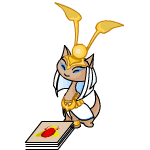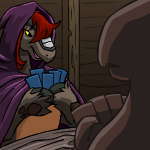 Puzzling Pyramids: A Guide to the Game
by kemppotatoe
--------
Welcome to a grueling game of Lupe kings, Aisha queens, and Zomutt jacks. This
tricky puzzle may have simple rules and an easy-to-understand goal, but it's like
walking onto a battlefield of intellectual Zafaras and bespectacled Yurbles. Strength
won't help you here. It all has to do with strategy...
It may not be the most popular puzzle in the game room. It may not be the
most rewarding in Neopoints. It may not be fun one hundred percent of the time.
But what the heck! I'm giving you a guide to the game of Pyramids... so go play
it and see if it's your kind of entertainment.
For those of you who have never played this easy-to-understand-yet-difficult-to-beat
game, let's do a quick cover of the rules and see how it's played. To start
off, your game board is in the shape of a pyramid (big surprise there, huh?),
with a base of seven right-side-up cards. Above those cards are six, then five,
then four, then three, then two, and then one. The only cards facing up are
the bottom seven; the rest are overturned. There is a stack of overturned cards
at the top of the screen, along with one card that is facing up. The bar at
the top of the screen has four sections. On the far left is the Consecutive
Plays, which we'll discuss later. The middle left section is the game points,
which is also the amount of Neopoints you win in the end. Middle right is how
many cards are left in the overturned pile (you begin with twenty-three), and
far right is all your Pyramid game scores put together to create your high score
for that three-month playing period.
Now it's time to start playing.
Pyramids is actually a lot like solitaire. In fact, if you type the word 'solitaire'
into the game search engine, Pyramids is one of the two games that comes up,
along with Sakhmet Solitaire. However, Sakhmet Solitaire is rated as an easy
game, and is on the Luck and Chance shelf of the game room. Pyramids is considered
at a medium difficulty level. Anyway, the goal in Pyramids is to clear all the
cards. Sure, it sounds easy, but just wait.
The active card is the one at the top that is right side up. For example,
let's say it's a 3. You look at the bottom seven cards and see if there is a
number either above or below a 3, but not a 3 itself. If there is a 2 or 4,
click on it and it becomes the active card. If there is nothing above or below
it available, you click on the pile to get a new active card. Overturned cards
become right side up when the two cards below it are cleared. You continue this
through the entire game. Remember that Consecutive Plays section at the top
of the screen? That shows how many times you didn't have to click on the overturned
pile in a row. Again, simple.
But Pyramids does have a lot to do with strategy. There are situations in
this game where you have to choose one card over another, and sometimes one
is actually a better pick. Now we will explore these situations, and find out
the right moves.
Scenario #1- Strategizing
Let's say your active card is a 2, and the cards you have to pick from are
5, 7, ace, and 3. Neither the 3 nor the ace will make the card above face up,
so it doesn't matter which one, right? Wrong. Let's say you pick the ace, and
then you get a new active card, which turns out to be a king. With a 3, 5, and
7 left, there's nothing you can do. However if you had picked the 3, the ace
would be there for the king. But what if a 4 came up instead of the king? Then
you'd have the five to use. Here's the point: if you can use two cards, check
if the number higher or lower than both cards can also be cleared with a different
card that is available. Again for example, since you could clear a 4 with a
3 and a 5, you use the 3 instead of the ace when your active card is 2. I know
it sounds complicated, but if you understand the example you can understand
it with any numbers.
Scenario #2- Reveal and Clear
You have an 8 as the active card, and a 5, 3, 7, 9, or 10 to choose from.
Choosing the 7 would reveal two more cards, and choosing the 9 and then 10 would
only unveil one. So, one way only gets rid of one card but shows two more, and
the other gets rid of two cards but only shows one more. This also has a lot
to do with the placement of the cards. If the 7 is on the bottom of the pyramid,
and the 9 and 10 are on one of the higher levels, I would choose the 7. If vice
versa, it has a lot to do with luck. If you choose the 7 and one of the two
new cards is an 8, you can get rid of all three options. But there's only a
two in thirteen chance of one of those cards being an 8. For this situation,
I usually tend to pick the one that uncovers two cards, but sometimes it is
smarter to do the other option. After all, it will get you more points.
Scenario #3- This or That?
Let's say the active card is 5 and the only two cards on the pyramid are 6
and 4. Which one to choose? If one of them uncovers more cards than the other,
choose that one, but if they both reveal that same amount, think about the cards
you've seen so far in the game. Remember - there are four of each type of card.
Perhaps there's a more likely chance of getting a 7 than a 3. If that's the
case, choose the 4 and hope to get a 7 or another 5 soon. Perhaps one of the
cards is slightly lower down the pyramid than the other. If that is the case,
I would suggest clearing the one farther down.
Scenario #4- Ordering Cards
It's the start of a new game. Your active card is 7, and your seven options
are 9, 10, 8, 5, 6, 7, 8 in that order. There are many things you can do, but
no way to clear each card. You can go: 8, 7, 6, 5/ 6, 7, 8, 9, 10/ or 8, 9,
8, 7, 6, 5. Obviously you are going to choose the one that clears the most cards,
so option three is your best bet. Remember when picking the order of your cards
to not just go up or down numerically without seeing if there's a twist. For
instance, in the above example, you could have just gone 8, 9, 10, but since
there's another 8 and numbers that can follow it, you can drop the 10 and go
8, 9, 8, 7, 6, 5. You don't always have to go numerically.
Scenario #5- Equal Values, so which one?
Often times near the end of the a game, you'll have only two choices, and
each will reveal one more card. This usually happens on the row with three cards,
when the middle one has already been cleared. If both cards are 9, and your
active card is 10, which one do you pick? Is there some trick to deciding which
one is a better choice? Unfortunately, no. It's the luck of the draw. Hopefully,
one of the cards that you can reveal is a 10 or 9, and hopefully you pick the
right one. But, again, just hope you're lucky.
Now you know what to do if you're ever in circumstances such as these five
while playing Pyramids! Remember: any numbers can be used for these scenarios!
I hope this guide really did help explain what you should do in this game, but
if not...
... maybe you'll get lucky!
Author's Note: I know this is a bit complicated and hard to understand,
but I do hope it helped you! I wrote this with every intention of explaining
some maneuvers in the game, not to make you utterly confused. However... I may
have failed. [o.O] Oh well.
| |
|
Search the Neopian Times
Great stories!
---------
---------
---------
 The Peophin Incident: Part Four The Peophin Incident: Part Four
To the right of him, he heard another voice
screaming, Run, you fool! But he couldn't run. All he could do was stand
there, terrified, his eyes shut tightly, waiting for the Snowager to come and
devour him...
by kyrinn |
---------
|
|